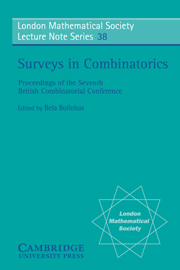Book contents
- Frontmatter
- Contents
- PREFACE
- 1 Resonance and reconstruction
- 2 Symmetry conditions in graphs
- 3 Extremal hypergraph problems
- 4 Connectivity and edge-connectivity in finite graphs
- 5 Partition theory and its applications
- 6 Strongly regular graphs
- 7 Geometries in finite projective and affine spaces
- 8 Long cycles in digraphs with constraints on the degrees
- 9 Colouring problems and matroids
- Index
3 - Extremal hypergraph problems
Published online by Cambridge University Press: 17 March 2010
- Frontmatter
- Contents
- PREFACE
- 1 Resonance and reconstruction
- 2 Symmetry conditions in graphs
- 3 Extremal hypergraph problems
- 4 Connectivity and edge-connectivity in finite graphs
- 5 Partition theory and its applications
- 6 Strongly regular graphs
- 7 Geometries in finite projective and affine spaces
- 8 Long cycles in digraphs with constraints on the degrees
- 9 Colouring problems and matroids
- Index
Summary
This talk is a review of recent developments in the study of extremal properties of set systems or hypergraphs.
We will begin with some examples of classical problems in this area; we will then discuss some recent results, and will finally discuss several conjectures and open problems. We apologize in advance for slighting important work (or contributors); in defence we note that while a review article can try to be encyclopaedic, nobody should be asked to listen to an encyclopaedic talk.
A graph is generally defined as a set of vertices and a set of pairs of vertices called arcs or lines or edges. A hypergraph similarly has vertices and hyperedges, which latter are here sets of vertices. A hypergraph is therefore another name for a collection of subsets of the vertices. We will refer particularly to several kinds of hypergraphs. A k-hypergraph has each of its members consisting of k vertices; an intersecting hypergraph has every pair of edges having at least one vertex in common. An antichain has no edge containing another; and an ideal has the property that any set of vertices contained in an edge is also an edge.
An extremal property is a statement that whatever possesses that property has to be or cannot be bigger than something or other.
The area that we are concerned with is not really extremal properties of hypergraphs per se (these are staggeringly trivial) but rather extremal properties of kinds of hypergraphs. Of course almost every mathematical construction contains within it some sort of hypergraph – so that almost any extremal property relates somehow to a kind of hypergraph.
- Type
- Chapter
- Information
- Surveys in Combinatorics , pp. 44 - 65Publisher: Cambridge University PressPrint publication year: 1979
- 7
- Cited by



